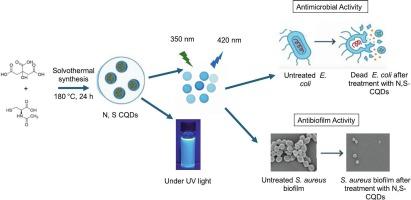多功能碳量子点:绿色合成,明亮发射,病原体抑制
IF 4.9
2区 化学
Q1 CHEMISTRY, ANALYTICAL
引用次数: 0
摘要
氮和硫共掺杂碳量子点(N, S-CQDs)由于其优异的光致发光特性和潜在的生物医学应用,特别是在对抗抗菌素耐药性和生物膜相关感染方面,已成为一种有前途的纳米材料。本研究以柠檬酸和N-乙酰- l-半胱氨酸为前体,采用绿色溶剂热法合成了N, S-CQDs,并对其进行了详细表征。理化分析表明,该材料具有较强的荧光性、丰富的表面官能团、接近中性的zeta电位和良好的结构稳定性。抑菌试验表明,合成的CQDs对多种病原菌(MIC: 4.375 ~ 17.5 mg/mL)和白色念珠菌(MIC: 35 mg/mL)具有显著的抑菌活性。它们还表现出很强的抗生物膜特性,可消除高达74%的成熟生物膜,并将生物膜产量减少75%至85%。有趣的是,CQDs在与微生物接触时保持其光学完整性,在被测微生物中发射峰保持稳定。这些发现支持了N, S-CQDs作为抗菌和抗生物膜剂的有效性。本文章由计算机程序翻译,如有差异,请以英文原文为准。

Multifunctional carbon quantum dots: green synthesis, bright emission, and pathogen suppression
Nitrogen and sulfur co-doped carbon quantum dots (N, S-CQDs) have emerged as promising nanomaterials due to their excellent photoluminescent properties and potential biomedical applications, particularly in combating antimicrobial resistance and biofilm-associated infections. This study presents the green solvothermal synthesis and detailed characterization of N, S-CQDs using citric acid and N-acetyl-L-cysteine as precursors. Physicochemical analysis revealed strong fluorescence, abundant surface functional groups, almost neutral zeta potential, and good structural stability. Antimicrobial testing showed that the synthesized CQDs exhibited significant activity against various bacterial pathogens (MICs: 4.375–17.5 mg/mL) and Candida albicans (MIC: 35 mg/mL). They also showed strong antibiofilm properties, eliminating mature biofilms by up to 74 % and decreasing biofilm production by 75 % to 85 %. Interestingly, the CQDs retained their optical integrity upon microbial contact, with the emission peak remaining stable across tested microorganisms. The effectiveness of N, S-CQDs as antimicrobial and antibiofilm agents is supported by these findings.
求助全文
通过发布文献求助,成功后即可免费获取论文全文。
去求助
来源期刊

Microchemical Journal
化学-分析化学
CiteScore
8.70
自引率
8.30%
发文量
1131
审稿时长
1.9 months
期刊介绍:
The Microchemical Journal is a peer reviewed journal devoted to all aspects and phases of analytical chemistry and chemical analysis. The Microchemical Journal publishes articles which are at the forefront of modern analytical chemistry and cover innovations in the techniques to the finest possible limits. This includes fundamental aspects, instrumentation, new developments, innovative and novel methods and applications including environmental and clinical field.
Traditional classical analytical methods such as spectrophotometry and titrimetry as well as established instrumentation methods such as flame and graphite furnace atomic absorption spectrometry, gas chromatography, and modified glassy or carbon electrode electrochemical methods will be considered, provided they show significant improvements and novelty compared to the established methods.
 求助内容:
求助内容: 应助结果提醒方式:
应助结果提醒方式:


